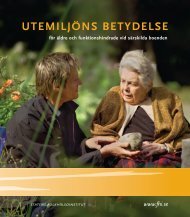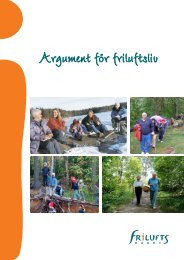Green Care: A Conceptual Framework - Frisk i naturen
Green Care: A Conceptual Framework - Frisk i naturen
Green Care: A Conceptual Framework - Frisk i naturen
You also want an ePaper? Increase the reach of your titles
YUMPU automatically turns print PDFs into web optimized ePapers that Google loves.
to sustainable development in urban areas (Relf and Lohr, 2003; Brethour<br />
et al, 2007).<br />
In addition to contributing to biological diversity and providing habitats<br />
for various plants, animals and insects, the ecological services and<br />
environmental benefits provided by urban and rural greenspaces include<br />
effects on microclimate, pollution and water dynamics and provide<br />
attractive views (Relf and Lohr, 2003; Brethour et al, 2007). Trees in<br />
cities can moderate the ‘heat island’ effect and can help to reduce climate<br />
extremes. <strong>Green</strong> infrastructure can provide shelter against wind and noise,<br />
and can reduce glare and reflection from buildings. Plants act as a sink for<br />
carbon and produce oxygen. Air quality improvements can occur from the<br />
removal of pollutants (both gaseous and particular contaminants) by urban<br />
trees. Plants have also been used to remove contaminants from soil. <strong>Green</strong>,<br />
natural areas reduce surface water run-off in built up areas, improving flood<br />
control and enabling the recharge of groundwater stocks.<br />
As previously highlighted in this report, nature and plants can provide<br />
stress reduction, decrease discomfort, introduce calming effects, increase<br />
positive emotions, reduce aggression, improve concentration, and<br />
encourage active and healthy lifestyles. Rural areas and urban greenspaces<br />
can provide areas in which city dwellers can relax and unwind and<br />
the health benefits associated with urban greening can range from the<br />
individual to the community and population level.<br />
Urban greening also provides economic benefits in terms of reduced<br />
heating and cooling costs for buildings, improved property values,<br />
enhanced beauty and improved privacy and security of buildings and<br />
communities (Relf and Lohr 2003; Brethour et al, 2007).<br />
Urban greening can bring about social benefits by raising the quality of<br />
neighbourhoods which in turn fosters civil behaviour and responsibilities.<br />
Increased social benefits are gained when citizens are actively involved<br />
in urban ‘community’ greening. Urban community greening refers “to<br />
the leadership and active participation of city residents who take it upon<br />
themselves to build healthier sustainable communities through planning<br />
and caring for “socio-ecological spaces” and the associated flora, fauna,<br />
and structures” (Tidball and Krasny, 2006). Communities have used urban<br />
greening projects successfully to combat against neighbourhood crime and<br />
other social problems. Urban community greening can therefore be a tool<br />
61















